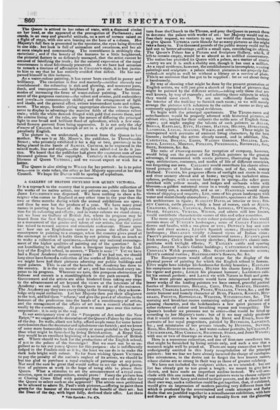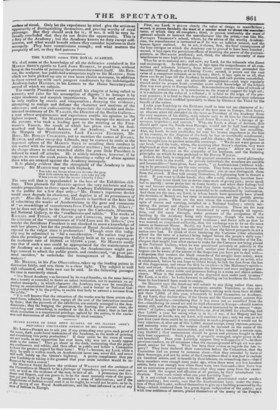A GALLERY OF BRITISH PICTURES FOR QUEEN VICTORIA.
Jr is a reproach to the country that it possesses no public collection of the works of its native artists, nor any private one, since the late Sir JOHN LEYCESTER'S was dispersed. We have nothing to show a foreigner who comes to Englund at any other time in the year than the two or three months during which the annual exhibitions are open ; and then he sees but the produce of a year. We have many great names in painting to boast of : the English school is in high estimation for its colouring and effects; and in water colours we stand alone ; yet we have no Gallery of British Art, where its progress may be traced from the first beginning, and to which we may proudly point as a monument of the genius and talent of our artists, that the nation has raised to reward success and stimulate endeavour. Shame upon us ! how can an Englishman venture to praise the efforts of his countrymen in painting to a stranger, when the country gives proof of the contempt in which it holds them by not prizing them so much as to make a collection of specimens,—leaving any national encouragement of the higher qualities of painting out of the question ? Is it riot humiliating to be obliged when a foreigner inquires for the Gallery of the English school, to answer, " There is none ! " Yet we have had a Royal Academy these seventy years ! If we had not, we should long since have formed a collection of tire works of British artists; and we might have had their pictures adorning our public buildings and royal palaces. This is one of the benefits the Academy has done to the country. It is the via inertia, of art ; and has cushioned every impetus to its progress. Wherever we turn, this pompous obstruction of dulness and conceit is a sturnblingblock in our path onward. The Government and the artists are alike hindered from taking any steps to the advancement of art beyond the views or the interests of the Academy : we can only look to the Queen to rid us of the nuisance. The Academy say they owe every thing to the Sovereign ; they acknowledge only royal authority. Let her Majesty then put their allegiance to the test, and bid them "reform," and give the power of election to the honours of the profession into the hands of a constituency of artists, and the management of the affairs of art into a council elected annually by the constituency. At present we must pass over this rotten corporation : it is only in the way. In our anticipatory view of the " Prospects of Art under the New Reign,"* we suggested the decoration of the Queen's Palace by the artists of the day. Its walls, albeit not lofty, afford ample room for some better enrichments than the decorator and upholsterer can furnish ; and we know of none more honourable to the country or more grateful to the Queen than what might be furnished by living British artists. A Royal Gallery would be an excellent beginning of a national collection of British art. Where should we look for the productions of the English school, if nat in the palace of the Sovereign ? But we must not be so un
gallant as to tax our young Queen for this purpose: she is indifferently lodged in the Pimlico sink as it is; the least we can do is to make the dark hole bright with colour. So far from wishing Queen VICTORIA to pay the penalty of the nation's neglect of its artists, we should be but too glad to purchase a royal example of patronage at any price. Nor need the sum be great that would suffice to set the whole generation of painters at work in the hope of being able to please their Queen. What a stimulus to art the announcement of a royal commission, open to all competitors, would prove ! Fancy the pieture-box at Charing Cross filled with paintings from one end to the other for the Queen to select such as she approved ! The artists once petitioned to be allowed to adorn St. Paul's with pictures,—offering to paint them gratis for the honour of the country and the benefit of their art; but the Dean of the day, with bigot folly, declined their offer. Let them • Vide Spectakr. to. 474.
turn from the Church to the Throne, and pray theQueen to permit them to decorate the palace with works of art : her Majesty would not refuse their request, we venture to say ; nor would the country hesitate to give Queen VICTORIA carte blanche for as many pictures as she might take a fancy to. Ten thousand pounds of the public money could not be laid out to better advantage ; and is a small sum, considering its object. The Queen's Palace has a Picture and Sculpture Gallery; which, if left to remain empty, would be as absurd as an unfilled conservatory. The nation has provided its Queen with a palace, as a matter of course —sorry we are it is such a shabby one, though it has cost a million. As aroyal residence, however, the establishment is incomplete, wanting paintings and sculpture : a palace without pictures is not properly fur.. ribbed—it might as yell be without a library or a service of plate. This is an omission that has got to be supplied : let us set about doing. it handsomely.
By way ot showing what might be done by the present generation of English artists, we will just give a sketch of the kind of pictures that might be painted by the different artists,—taking only those that are well known, by way of example ; and selecting those subjects in which they would most excel. We are not sufficiently familiar with the interior of the building to furnish each room ; so we will merely arrange the pictures with reference to the suites of rooms as they are commonly appropriated in a royal residence. To begin with the principal apartments. The Throne-room and antechambers would be properly adorned with historical pictures, of cabinet size, having for their subjects the noble acts of English Sovereigns ; mid might employ the talents of such painters as ALLAN, BRIGGS, EASTLAKF:, ETTY, HAYDON, HATTER, HILTON, HURLSTONE, Lasost:ea, LESLIE, MaCLISE, WILKIE, and others. These might be interspersed with portraits of eminent living characters, by the best limners ; including the artists already named, and in addition, Mrs. CARPENTER, BOADEN, EDDIS, WATSON GORDON, HOI.LINS, LAW. RENCE, LINNELL, MORTON, PHILLIPS, PICKERSGILL, ROTHWELL, SAY, SHEE, SIMPSON, &C. &C.
The suite of Drawing-rooms for reception of company, however, would bring out the genius of the English painters to the greatest advantage, if ornamented with scenic pictures, illustrating the landscape, architecture, costumes, and modes of life of different countries, not forgetting our own. CALLCOTT would contribute his chaste silvertoned pictures of Italian lakes and cities, and of flat, cold, watery Holland : TURNER, his gorgeous effects of sunlight and storm in coast and river scenery abroad and at bome; varying his turbulent atmospheres, perhaps, with a serene landscape in spring—the sober green enriched with yellow meads, and hedges and orchards white with blossom—a golden autumnal scene in a woody country, a snow piece with wintry sun, a moonlight, and so on : STANFIELD would supply views of shipping and seaports ; LEE, some of his green landscapes with water and moist cloudy atmosphere ; ROBERTS, specimens of the Moorish architecture in Spain ; ScanErr DAVIS, an intetior or two ; SIDNEY COOPER, cattle pieces ; while a host of names, such as ALLEN, CHAMBERS, COOKV, CRESWICK, JONES, LINNELL, O'CONNOR, PYNE, STARK, STANLEY, VICKERS, WILSON, and others still less known, would contribute characteristic scenes of this and other countries.
The room appropriated to water colour paintings of this class would contain more of TritNER's landscapes; some of COPLEY FIELDING'S downs and heaths, with a sea-piece or two ; DEWINT'S hay and corn fields and river scenes ; LEWIS'S Spanish scenes ; HARDING'S noble landscapes ; HOLLAND'S vividly coloured views of Italian cities; Paour's picturesque peeps of old Continental towns ; EVANS'S green Irish scenes ; Cox's fresh breezy sketches ; BARRETT'S classic compositions with twilight effects; F. TAYLER'S cattle and sporting pieces; JOSEPH NASH'S Gothic buildings ; CATTERMOLE'S interiors; CitisTaWs Welsh peasants ; Mrs. SEYFFARTH'S dollICSIiC scenes; HUNT'S comical rustics ; BARTHOLOMEW'S flowers, ikc. The Banquet-room would afford scope for the display of the physical power of painting for which the English school is famous. ETTY might here indulge his fondness for fleshly beauties ; EASTLAKE his sumptuous taste in costume; HILTON his chaste fancy ; HAYDON his vigour and gusto ; LESLIE his pleasant humour; Lastnsesat exhibit his animali par/arta ; and LANCE vie with Nature in fruit arid gems.
The more private apartments would have interspersed among the lesser works of the leading painters we have named, graceful poetical fancies of BODDINGTON, BOXALL, COPE, DYCE, HARVEY, HERBERT, INSKIPP, CHARLES LANDSEER, PENRY, WILLIAMS, UWINS, &C. ; and the comic humour and homely character of Buss, FRASER, KNIGHT, Mut READY, PRENTIS, RIPPINGILLE, WEBSTER, WITHERINGTON, &C. The morning and breakfast-rooms containing subjects of a cheerful and pleasing character, and the bedchambers a few quiet pictures of a sober richness of colour and breathing repose and tranquillity. The
Queen's boudoir we presume not to enter—that would be fitted up according to .her Majesty's taste; but of it we may safely predicate that it would contain a few enamels by 13osie and ESSEX, from the portraits of her royal progenitors, painted by REYNOLDS, LAWRENCE, &C. ; and miniatures of her private friends, by DENNING, M.wro,v,, Ross,Mrs. ROBERTSON, &C. ; and water. colour portraits, by Cusi.0.41.. Cnumicsnastx, Miss CORBAUX, RICHMOND, STONE, and JOHN WRIGHT; with one or two of drawings on stone by LANE.
Here is a numerous collection, and one of first-rate excellence too, that might be furnished by living artists only, and such a one that a monarch might well be proud of There are many names that we have undesignedly omitted in this hasty recapitulation of the principal painters; but we fear we have already incurred the charge of cataloguelike minuteness, in the desire not to forget the less known names, whose claims are as strong in their way as those of greater celebrity. We have not included the sculptors either, as we intended: but our list has already got to too great a length : we meant to give but a sketch, and have made an imperfect outline instead. We will conclude with this one remark, that if our painters were to choose subjects congenial to their fancy and suited to their powers, and do their hest in their own way, such a collection could be got together, that, if exhibited, would give an impression of modern painting very different from that which is produced by the overstrained and crude attempts and flashy daubs that are jumbled together in a miscellaneous exhibition, with here and there a gem shining brightly and steadily from out the glittering'
Solace of tinsel. Only let the experiment be tried : give the artists an oppeetunity of distinguishing themselves, and proving worthy of royal patronage. But they should seek for it ; if not, it will be very rationally condtided that they do not desire the opportunity. This is a duty of the Academy; but the Academy knows no duty except selfinterest, and what would benefit others they consider injurious to their monopoly. They have commissions enough ; and what matters the prosperity of art, so they find patrons ?



























 Previous page
Previous page